Cytotoxic Effects of Doxorubicin on Cancer Cells and Macrophages Depend Differently on the Microcarrier Structure
Abstract
:1. Introduction
2. Materials and Methods
2.1. Materials
2.2. Methods
2.2.1. Fabrication of Microstructures of Different Types
Synthesis of Calcium Carbonate Microbeads
Preparation of Core/Shell Microparticles and Microcapsules
Loading of Doxorubicin into the Microstructures
2.2.2. Scanning Electron Microscopy
2.2.3. Cell Culture
2.2.4. MTT Assay
- -
- Microstructures containing DOX in the final concentration range from 0 to 9 µM: MB-DOX; MB(+8L)-DOX; MC(8L)-DOX.
- -
- Microstructures not containing DOX (control samples) at a ratio from 0 to 50 microstructures per cell: MB; MB(+8L); MC(8L).
- -
- A DOX solution in the concentration range from 0 to 9 µM in the complete medium.
2.2.5. Inhibitory Dose Estimation and Statistical Analysis of Data
3. Results and Discussion
3.1. Preparation and Characterization of Microstructures of Different Types
3.2. Release of Doxorubicin from the Microcarriers
3.3. Cell Viability in the Presence of the Microstructures
4. Conclusions
Author Contributions
Funding
Institutional Review Board Statement
Informed Consent Statement
Data Availability Statement
Acknowledgments
Conflicts of Interest
References
- Ferlay, J.; Ervik, M.; Lam, F.; Laversanne, M.; Colombet, M.; Mery, L.; Piñeros, M.; Znaor, A.; Soerjomataram, I.; Bray, F. Global Cancer Observatory: Cancer Today; International Agency for Research on Cancer: Lyon, France, 2024; Available online: https://gco.iarc.who.int/today (accessed on 8 February 2024).
- Sylvestre, M.; Tarte, K.; Roulois, D. Epigenetic mechanisms driving tumor supportive microenvironment differentiation and function: A role in cancer therapy? Epigenomics 2020, 12, 157–169. [Google Scholar] [CrossRef] [PubMed]
- Dagogo-Jack, I.; Shaw, A. Tumour heterogeneity and resistance to cancer therapies. Nat. Rev. Clin. Oncol. 2018, 15, 81–94. [Google Scholar] [CrossRef] [PubMed]
- Danenberg, E.; Bardwell, H.; Zanotelli, V.R.T.; Provenzano, E.; Chin, S.-F.; Rueda, O.M.; Green, A.; Rakha, E.; Aparicio, S.; Ellis, I.O.; et al. Breast tumor microenvironment structures are associated with genomic features and clinical outcome. Nat. Genet. 2022, 54, 660–669. [Google Scholar] [CrossRef] [PubMed]
- Malta, T.M.; Noushmehr, H. The cancer genome atlas research Network. The immune landscape of cancer. Immunity 2018, 48, 812–830. [Google Scholar] [CrossRef] [PubMed]
- Xia, Y.; Sun, M.; Huang, H.; Jin, W.L. Drug repurposing for cancer therapy. Signal Transduct. Target. Ther. 2024, 9, 92. [Google Scholar] [CrossRef] [PubMed]
- Wei, G.; Wang, Y.; Yang, G.; Wang, Y.; Ju, R. Recent progress in nanomedicine for enhanced cancer chemotherapy. Theranostics 2021, 11, 6370. [Google Scholar] [CrossRef] [PubMed]
- Manzari, M.T.; Shamay, Y.; Kiguchi, H.; Rosen, N.; Scaltriti, M.; Heller, D.A. Targeted drug delivery strategies for precision medicines. Nat. Rev. Mater. 2021, 6, 351–370. [Google Scholar] [CrossRef] [PubMed]
- Di Nardo, P.; Lisanti, C.; Garutti, M.; Buriolla, S.; Alberti, M.; Mazzeo, R.; Puglisi, F. Chemotherapy in patients with early breast cancer: Clinical overview and management of long-term side effects. Expert Opin. Drug Saf. 2022, 21, 1341–1355. [Google Scholar] [CrossRef]
- Shi, J.; Kantoff, P.W.; Wooster, R.; Farokhzad, O.C. Cancer nanomedicine: Progress, challenges and opportunities. Nat. Rev. Cancer 2017, 17, 20–37. [Google Scholar] [CrossRef]
- Timin, A.S.; Gao, H.; Voronin, D.V.; Gorin, D.A.; Sukhorukov, G.B. Inorganic/organic multilayer capsule composition for improved functionality and external triggering. Adv. Mater. Interfaces 2017, 4, 1600338. [Google Scholar] [CrossRef]
- Novoselova, M.V.; Loh, H.M.; Trushina, D.B.; Ketkar, A.; Abakumova, T.O.; Zatsepin, T.S.; Kakran, M.; Brzozowska, A.M.; Lau, H.H.; Gorin, D.A.; et al. Biodegradable polymeric multilayer capsules for therapy of lung cancer. ACS Appl. Mater. Interfaces 2020, 12, 5610–5623. [Google Scholar] [CrossRef]
- Kudryavtseva, V.; Boi, S.; Read, J.; Guillemet, R.; Zhang, J.; Udalov, A.; Shesterikov, E.; Tverdokhlebov, S.; Pastorino, L.; Gould, D.J.; et al. Biodegradable defined shaped printed polymer microcapsules for drug delivery. ACS Appl. Mater. Interfaces 2021, 13, 2371–2381. [Google Scholar] [CrossRef]
- Nifontova, G.; Krivenkov, V.; Zvaigzne, M.; Efimov, A.; Korostylev, E.; Zarubin, S.; Karaulov, A.; Nabiev, I.; Sukhanova, A. Nanoparticle-doped hybrid polyelectrolyte microcapsules with controlled photoluminescence for potential bioimaging applications. Polymers 2021, 13, 4076. [Google Scholar] [CrossRef]
- Nifontova, G.; Tsoi, T.; Karaulov, A.; Nabiev, I.; Sukhanova, A. Structure-function relationships in polymeric multilayer capsules designed for cancer drug delivery. Biomater. Sci. 2022, 10, 5092–5115. [Google Scholar] [CrossRef] [PubMed]
- Sritharan, S.; Sivalingam, N. A comprehensive review on time-tested anticancer drug doxorubicin. Life Sci. 2021, 278, 119527. [Google Scholar] [CrossRef] [PubMed]
- Fraczkowska, K.; Bacia, M.; Przybyło, M.; Drabik, D.; Kaczorowska, A.; Rybka, J.; Stefanko, E.; Drobczynski, S.; Masajada, J.; Podbielska, H.; et al. Alterations of biomechanics in cancer and normal cells induced by doxorubicin. Biomed. Pharmacother. 2018, 97, 1195–1203. [Google Scholar] [CrossRef]
- Christidi, E.; Brunham, L.R. Regulated cell death pathways in doxorubicin-induced cardiotoxicity. Cell Death Dis. 2021, 12, 339. [Google Scholar] [CrossRef]
- Wang, J.; Hao, H.; Cai, J.H. Amphiphilic drug delivery microcapsules via layer-by-layer self-assembly. J. Polym. Sci. Part B Polym. Phys. 2019, 58, 535–550. [Google Scholar] [CrossRef]
- Trushina, D.B.; Akasov, R.A.; Khovankina, A.V.; Borodina, T.N.; Bukreeva, T.V.; Markvicheva, E.A. Doxorubicin-loaded biodegradable capsules: Temperature induced shrinking and study of cytotoxicity in vitro. J. Mol. Liq. 2019, 284, 215–224. [Google Scholar] [CrossRef]
- Kalenichenko, D.; Nifontova, G.; Sukhanova, A.; Nabiev, I. Design and characterisation of calcium carbonate microspheres for anticancer drug delivery. J. Phys. Conf. Ser. 2021, 2058, 012009. [Google Scholar] [CrossRef]
- Kalenichenko, D.; Nifontova, G.; Karaulov, A.; Sukhanova, A.; Nabiev, I. Designing functionalized polyelectrolyte microcapsules for cancer treatment. Nanomaterials 2021, 11, 3055. [Google Scholar] [CrossRef]
- Nifontova, G.; Kalenichenko, D.; Kriukova, I.; Terryn, C.; Audonnet, S.; Karaulov, A.; Nabiev, I.; Sukhanova, A. Impact of macrophages on the interaction of cetuximab-functionalized polyelectrolyte capsules with EGFR-expressing cancer cells. ACS Appl. Mater. Interfaces 2023, 15, 52137–52149. [Google Scholar] [CrossRef]
- Kim, A.L.; Musin, E.V.; Oripova, M.J.; Oshchepkova, Y.I.; Salikhov, S.I.; Tikhonenko, S.A. Polyelectrolyte microcapsules—A promising target delivery system of amiodarone with the possibility of prolonged release. Int. J. Mol. Sci. 2023, 24, 3348. [Google Scholar] [CrossRef]
- Hu, Y.; Zhang, J.; Hu, H.; Xu, S.; Xu, L.; Chen, E. Gefitinib encapsulation based on nano-liposomes for enhancing the curative effect of lung cancer. Cell Cycle 2020, 19, 3581–3594. [Google Scholar] [CrossRef]
- Mattiazzi, J.; Sari, M.H.M.; Araujo, P.C.O.; Englert, A.V.; Nadal, J.M.; Farago, P.V.; Nogueira, C.W.; Cruz, L. Ethylcellulose microparticles enhance 3,3′-diindolylmethane anti-hypernociceptive action in an animal model of acute inflammatory pain. J. Microencapsul. 2020, 37, 528–541. [Google Scholar] [CrossRef]
- Meng, Q.; Zhong, S.; Wang, J.; Gao, Y.; Cui, X. 10-hydroxycamptothecin-loaded starch-based microcapsules with the stepwise responsive release strategy for targeted controlled release. Int. J. Biol. Macromol. 2023, 252, 126424. [Google Scholar] [CrossRef] [PubMed]
- Sun, H.; Wong, E.H.; Yan, Y.; Cui, J.; Dai, Q.; Guo, J.; Qiao, G.G.; Caruso, F. The role of capsule stiffness on cellular processing. Chem. Sci. 2015, 6, 3505–3514. [Google Scholar] [CrossRef] [PubMed]
- Palomba, R.; Palange, A.L.; Rizzuti, I.F.; Ferreira, M.; Cervadoro, A.; Barbato, M.G.; Canale, C.; Decuzzi, P. Modulating phagocytic cell sequestration by tailoring nanoconstruct softness. ACS Nano 2018, 12, 1433–1444. [Google Scholar] [CrossRef] [PubMed]
- Hartmann, R.; Weidenbach, M.; Neubauer, M.; Fery, A.; Parak, W.J. Stiffness-dependent in vitro uptake and lysosomal acidification of colloidal particles. Angew. Chem. Int. Ed. Engl. 2015, 54, 1365–1368. [Google Scholar] [CrossRef]
- Akdeniz, B.; Wood, J.A.; Lammertink, R.G.H. Diffusiophoretic behavior of polyelectrolyte-coated particles. Langmuir 2024, 40, 5934–5944. [Google Scholar] [CrossRef]
- Shekunov, B.Y.; Chattopadhyay, P.; Tong, H.H.; Chow, A.H. Particle size analysis in pharmaceutics: Principles, methods and applications. Pharm. Res. 2007, 24, 203–227. [Google Scholar] [CrossRef]
- Komatsu, S.; Yamada, S.; Kikuchi, A. Preparation of degradable and transformable core–corona-type particles that control cellular uptake by thermal shape change. ACS Biomater. Sci. Eng. 2024, 10, 897–904. [Google Scholar] [CrossRef] [PubMed]
- Trushina, D.B.; Bukreeva, T.V.; Antipina, M.N. Size-controlled synthesis of vaterite calcium carbonate by the mixing method: Aiming for nanosized particles. Cryst. Growth Des. 2016, 16, 1311–1319. [Google Scholar] [CrossRef]
- Ma, Y.; Wang, A.; Li, J.; Li, Q.; Han, Q.; Jing, Y.; Zheng, X.; Cao, H.; Yan, X.; Bai, S. Surface self-assembly of dipeptides on porous CaCO3 particles promoting cell internalization. ACS Appl. Mater. Interfaces 2023, 15, 2486–2497. [Google Scholar] [CrossRef]
- Bosio, V.E.; Cacicedo, M.L.; Calvignac, B.; León, I.; Beuvier, T.; Boury, F.; Castro, G.R. Synthesis and characterization of CaCO3–biopolymer hybrid nanoporous microparticles for controlled release of doxorubicin. Colloids Surf. B Biointerfaces 2014, 123, 158–169. [Google Scholar] [CrossRef]
- Pallaeva, T.N.; Mikheev, A.V.; Khmelenin, D.N.; Eurov, D.A.; Kurdyukov, D.A.; Popova, V.K.; Dmitrienko, E.V.; Trushina, D.B. High-capacity calcium carbonate particles as pH-sensitive containers for doxorubicin. Crystallogr. Rep. 2023, 68, 309–315. [Google Scholar] [CrossRef]
- Kastl, L.; Sasse, D.; Wulf, V.; Hartmann, R.; Mircheski, J.; Ranke, C.; Carregal-Romero, S.; Martínez-López, J.A.; Fernández-Chacón, R.; Parak, W.J.; et al. Multiple internalization pathways of polyelectrolyte multilayer capsules into mammalian cells. ACS Nano 2013, 7, 6605–6618. [Google Scholar] [CrossRef] [PubMed]
- Navolokin, N.A.; German, S.V.; Bucharskaya, A.B.; Godage, O.S.; Zuev, V.V.; Maslyakova, G.N.; Pyataev, N.A.; Zamyshliaev, P.S.; Zharkov, M.N.; Terentyuk, G.S.; et al. Systemic administration of polyelectrolyte microcapsules: Where do they accumulate and when? In vivo and ex vivo study. Nanomaterials 2018, 8, 812. [Google Scholar] [CrossRef]
- Choukrani, G.; Maharjan, B.; Park, C.H.; Kim, C.S.; Kurup Sasikala, A.R. Biocompatible superparamagnetic sub-micron vaterite particles for thermo-chemotherapy: From controlled design to in vitro anticancer synergism. Mater. Sci. Eng. C Mater. Biol. Appl. 2020, 106, 110226. [Google Scholar] [CrossRef]
- Zhang, Y.; Cai, L.; Li, D.; Lao, Y.-H.; Liu, D.; Li, M.; Ding, J.; Chen, X. Tumor microenvironment-responsive hyaluronate-calcium carbonate hybrid nanoparticle enables effective chemotherapy for primary and advanced osteosarcomas. Nano Res. 2018, 11, 4806–4822. [Google Scholar] [CrossRef]
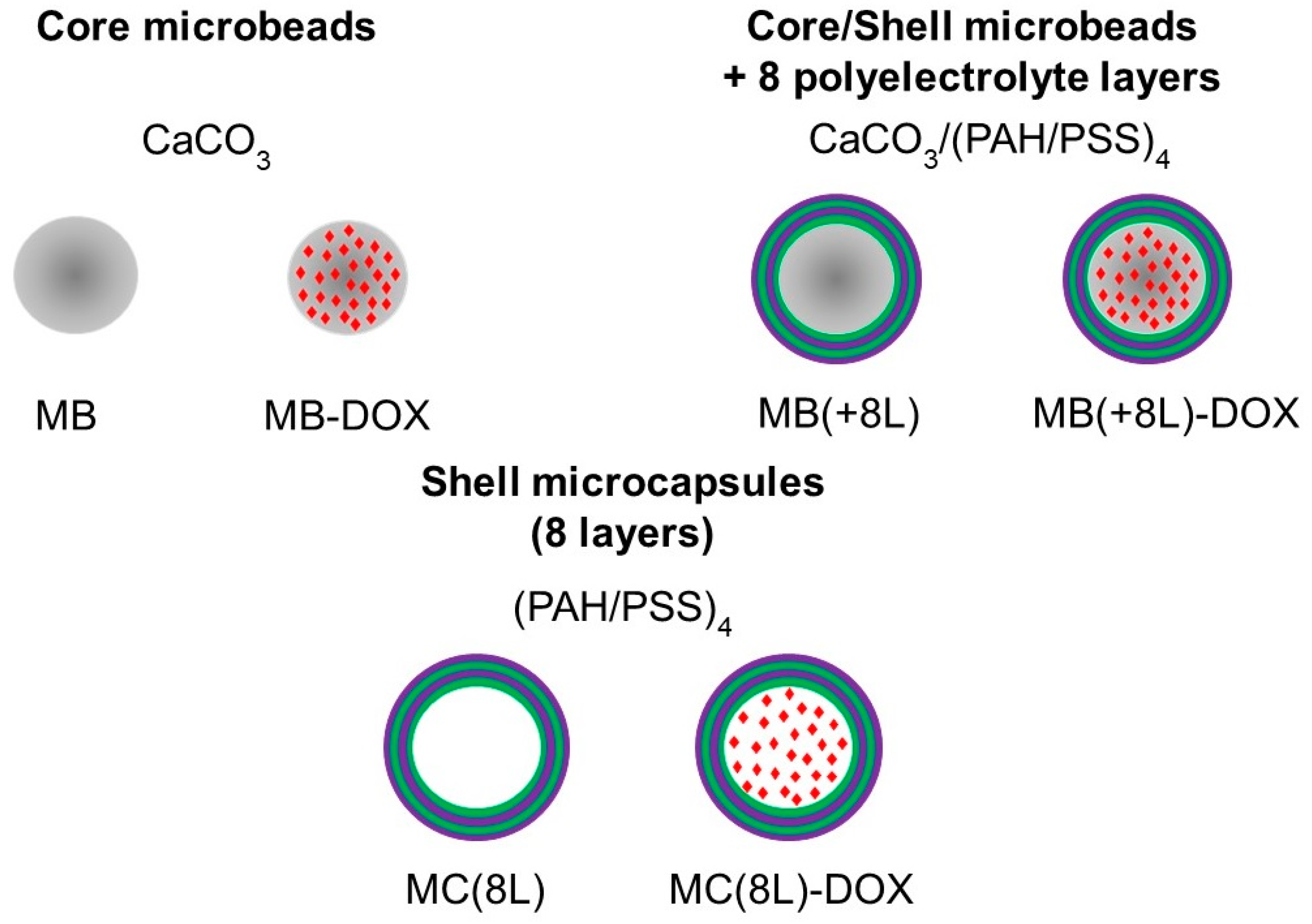
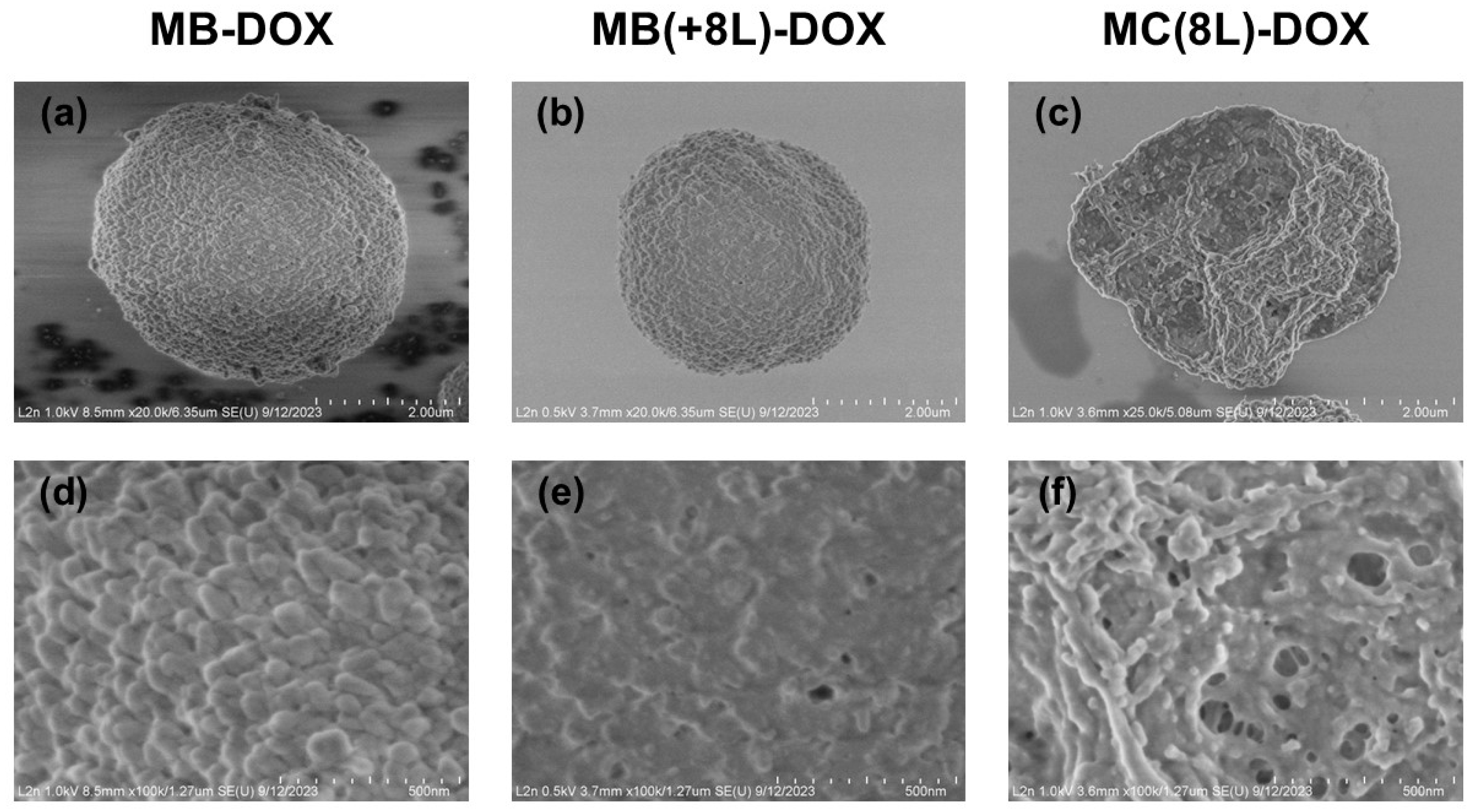
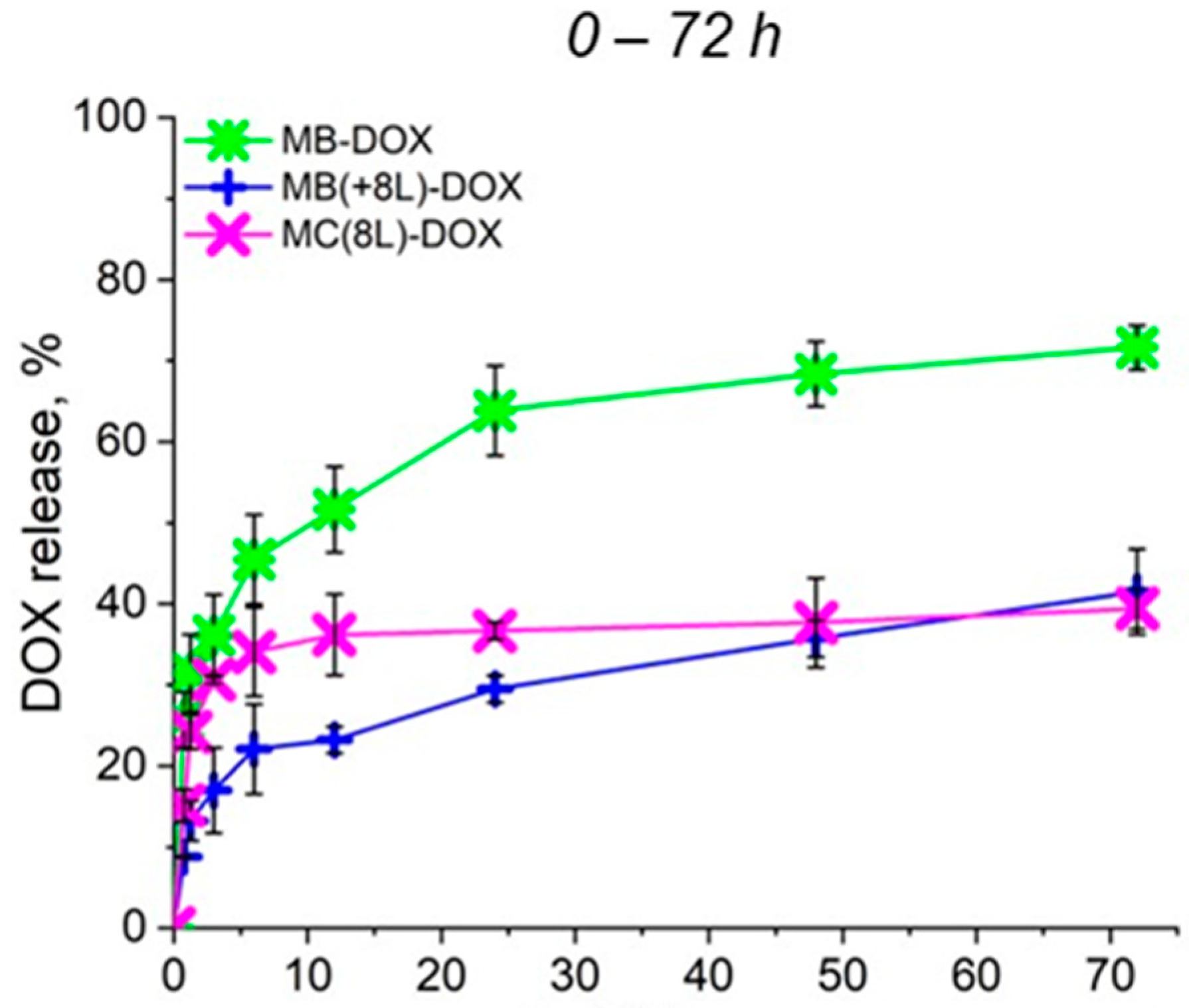


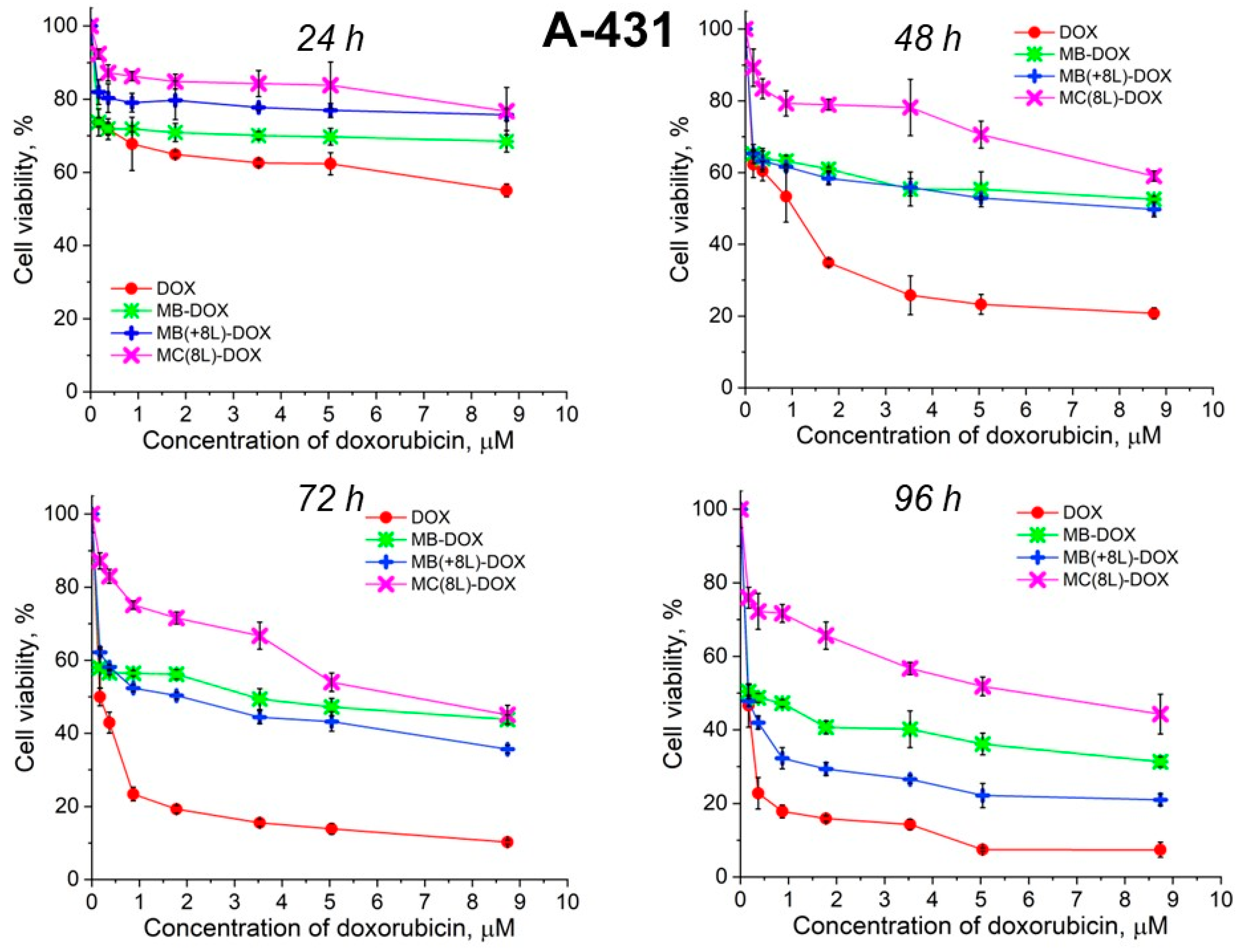
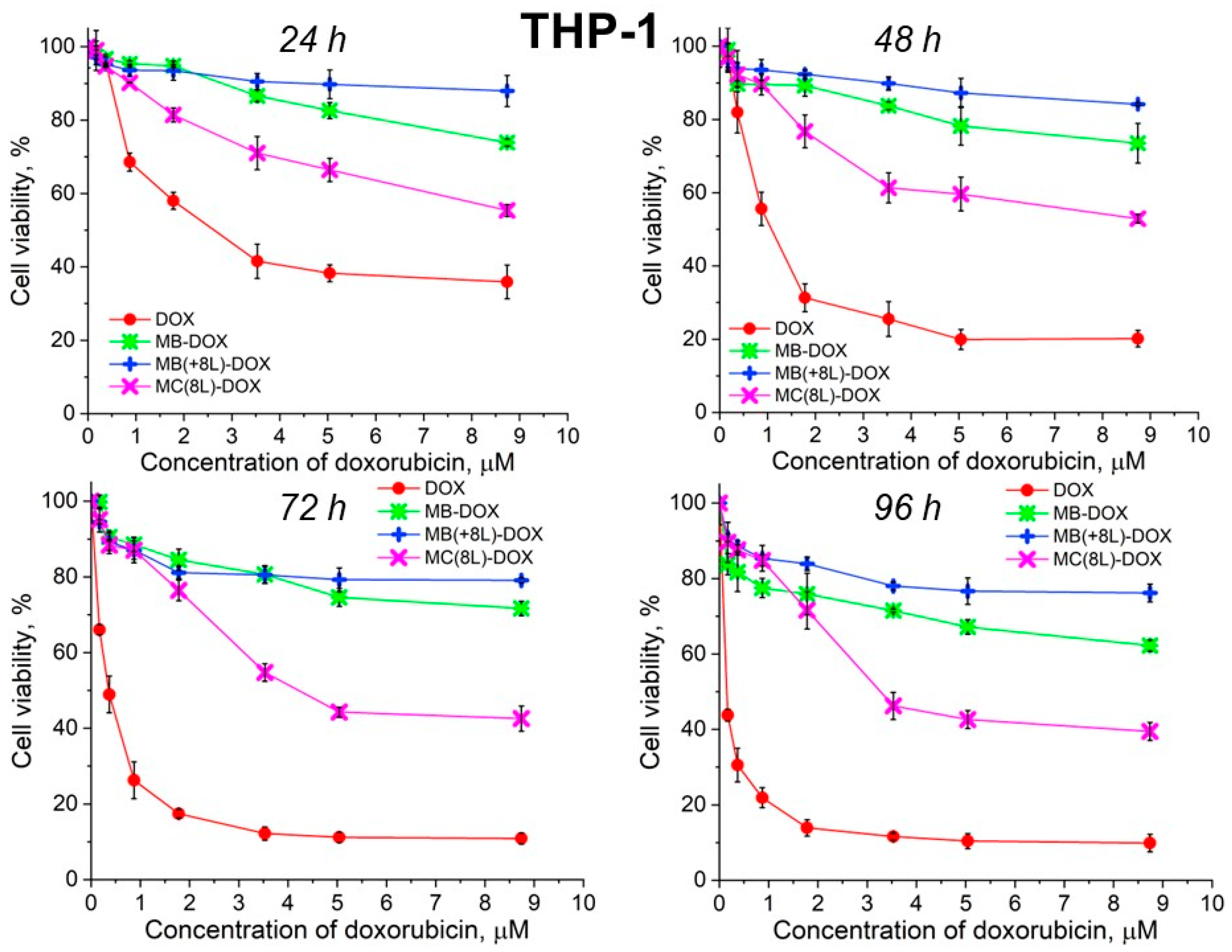
| Sample 1 | Loading Efficiency, % | Amount of DOX per Microcarrier, µg |
|---|---|---|
| MB-DOX | 76.4 ± 2.9 | 2 × 10−6 ± 5.8 × 10−7 |
| MB(+8L)-DOX | 74.3 ± 4.8 | 1.96 × 10−6 ± 1.3 × 10−7 |
| MC(8L)-DOX | 73.9 ± 3.9 | 1.9 × 10−6 ± 1 × 10−7 |
| Number of Particles per Cell | 1 | 2 | 5 | 10 | 20 | 30 | 50 |
|---|---|---|---|---|---|---|---|
| Average Concentration of DOX 1, µM | 0.175 ± 0.004 | 0.371 ± 0.008 | 0.878 ± 0.019 | 1.79 ± 0.039 | 3.55 ± 0.075 | 5.06 ± 0.111 | 8.78 ± 0.192 |
| Sample 1 | IC Values, Particles per Cell | |||
|---|---|---|---|---|
| Agent Type | 24 h | 48 h | 72 h | 96 h |
| MB | IC20 = 5.5 ± 0.03 | IC20 = 3.5 ± 0.06 | IC20 = 3.25 ± 0.05 | IC20 = 0.5 ± 0.2 |
| MB(+8L) | IC20 – | IC20 = 33.3 ± 0.04 | IC20 = 10.8 ± 0.08 | IC20 = 11.01 ± 0.03 |
| MC(8L) | IC20 – | IC20 – | IC20 – | IC20 = 22.2 ± 0.05 |
| Sample 1 | IC Values, Particles per Cell | |||
|---|---|---|---|---|
| Agent Type | 24 h | 48 h | 72 h | 96 h |
| MB | IC20 – | IC20 = 42.4 ± 0.08 | IC20 = 22.5 ± 0.06 | IC20 = 7.2 ± 0.02 |
| MB(+8L) | IC20 – | IC20 – | IC20 – | IC20 – |
| MC(8L) | IC20 = 32.3 ± 0.03 | IC20 = 31.2 ± 0.05 | IC20 = 6.2 ± 0.09 | IC20 = 0.6 ± 0.03 |
| Sample 1 | IC Values | |||
|---|---|---|---|---|
| Agent Type | 24 h | 48 h | 72 h | 96 h |
| DOX | IC20 = 0.06 ± 0.017 IC50 – | IC20 = 0.03 ± 0.02 IC50 = 1.09 ± 0.07 | IC20 = 0.018 ± 0.04 IC50 = 0.17 ± 0.03 | IC20 = 0.01 ± 0.05 IC50 = 0.085 ± 0.04 |
| MB-DOX | IC20 = 0.08 ± 0.03 IC50 – | IC20 = 0.04 ± 0.02 IC50 – | IC20 = 0.02 ± 0.04 IC50 = 3.22 ± 0.03 | IC20 = 0.005 ± 0.002 IC50 = 0.15 ± 0.015 |
| MB(+8L)-DOX | IC20 = 0.36 ± 0.06 IC50 – | IC20 = 0.08 ± 0.05 IC50 = 7.56 ± 0.43 | IC20 = 0.04 ± 0.025 IC50 = 1.71 ± 0.02 | IC20 = 0.02 ± 0.003 IC50 = 0.12 ± 0.07 |
| MC(8L)-DOX | IC20 = 5.14 ± 0.04 IC50 – | IC20 = 0.75 ± 0.35 IC50 – | IC20 = 0.47 ± 0.08 IC50 = 6.24 ± 0.52 | IC20 = 0.08 ± 0.04 IC50 = 5.33 ± 0.07 |
| Sample 1 | IC Values | |||
|---|---|---|---|---|
| Agent Type | 24 h | 48 h | 72 h | 96 h |
| DOX | IC20 = 0.54 ± 0.05 IC50 = 2.83 ± 0.06 | IC20 = 0.38 ± 0.08 IC50 = 0.91 ± 0.04 | IC20 = 0.19 ± 0.06 IC50 = 0.35 ± 0.05 | IC20 – IC50 = 0.17 ± 0.04 |
| MB-DOX | IC20 = 4.89 ± 0.03 IC50 – | IC20 = 4.81 ± 0.03 IC50 – | IC20 = 1.78 ± 0.1 IC50 – | IC20 = 0.81 ± 0.06 IC50 – |
| MB(+8L)-DOX | IC20 – IC50 – | IC20 – IC50 – | IC20 = 3.45 ± 0.04 IC50 – | IC20 = 3.44 ± 0.34 IC50 – |
| MC(8L)-DOX | IC20 = 1.54 ± 0.2 IC50 – | IC20 = 1.61 ± 0.03 IC50 – | IC20 = 1.25 ± 0.04 IC50 = 4.05 ± 0.01 | IC20 = 0.94 ± 0.02 IC50 = 2.55 ± 0.6 |
Disclaimer/Publisher’s Note: The statements, opinions and data contained in all publications are solely those of the individual author(s) and contributor(s) and not of MDPI and/or the editor(s). MDPI and/or the editor(s) disclaim responsibility for any injury to people or property resulting from any ideas, methods, instructions or products referred to in the content. |
© 2024 by the authors. Licensee MDPI, Basel, Switzerland. This article is an open access article distributed under the terms and conditions of the Creative Commons Attribution (CC BY) license (https://creativecommons.org/licenses/by/4.0/).
Share and Cite
Kalenichenko, D.; Kriukova, I.; Karaulov, A.; Nabiev, I.; Sukhanova, A. Cytotoxic Effects of Doxorubicin on Cancer Cells and Macrophages Depend Differently on the Microcarrier Structure. Pharmaceutics 2024, 16, 785. https://doi.org/10.3390/pharmaceutics16060785
Kalenichenko D, Kriukova I, Karaulov A, Nabiev I, Sukhanova A. Cytotoxic Effects of Doxorubicin on Cancer Cells and Macrophages Depend Differently on the Microcarrier Structure. Pharmaceutics. 2024; 16(6):785. https://doi.org/10.3390/pharmaceutics16060785
Chicago/Turabian StyleKalenichenko, Daria, Irina Kriukova, Alexander Karaulov, Igor Nabiev, and Alyona Sukhanova. 2024. "Cytotoxic Effects of Doxorubicin on Cancer Cells and Macrophages Depend Differently on the Microcarrier Structure" Pharmaceutics 16, no. 6: 785. https://doi.org/10.3390/pharmaceutics16060785
APA StyleKalenichenko, D., Kriukova, I., Karaulov, A., Nabiev, I., & Sukhanova, A. (2024). Cytotoxic Effects of Doxorubicin on Cancer Cells and Macrophages Depend Differently on the Microcarrier Structure. Pharmaceutics, 16(6), 785. https://doi.org/10.3390/pharmaceutics16060785








